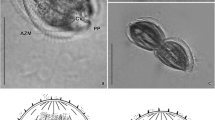Summary
The flagellated chambers of Ephydatia fluviatilis arise at scattered sites within the mesenchyme. Each such site is marked by an accumulation of rounded cells, which appear to be derived from archaeocytes in most respects except that they are smaller than the latter and have no nucleoli in the nucleus. These are choanoblasts, which first develop a flagellum and later a collar; eventually, as choanocytes, they become arranged so as to form a flagellated chamber.
Having reached this preliminary stage of completion in the mesenchyme, the flagellated chambers migrate to the endopinacocyte epithelium of the excurrent canal system. Then the choanocytes at the contact point are converted to cone cells. The endopinacocyte epithelium in turn responds by developing one pore cell for each flagellated chamber. The porocytes become permanently joined to the chamber by way of the adjacent cone cells, and from this time on the flagellated chamber is functional.
Zusammenfassung
Die Kragengeißelkammern von Ephydatia fluviatilis entstehen frei im Mesenchym. An den Entstehungsorten trifft man auf Anhäufungen rundlicher Zellen, die allem Anschein nach von Archäocyten stammen, jedoch kleiner sind als diese und einen nukleoluslosen Kern besitzen. Hierbei handelt es sich um Choanoblasten, die zunächst eine Geißel, später den Kragen ausbilden und sich als Choanocyten zu Kragengeißelkammern zusammenfügen.
Die im Mesenchym vorläufig fertiggestellten Kragengeißelkammern gelangen an das Endopinacocytenepithel des ausführenden Kanalysystems. Daraufhin bilden sich die tangierten Choanocyten zu Konuszellen um. Das Endopinacocytenepithel antwortet seinerseits mit der Ausbildung einer Poruszelle pro Kragengeißelkammer. Die Porocyten gehen mittels der konfrontierten Konuszellen dauerhafte Verbindungen mit den zugehörigen, nunmehr funktionstüchtigen Kragengeißelkammern ein.
Similar content being viewed by others
Abbreviations
- A:
-
Archäocyte
- aK:
-
ausführender Kanal
- B:
-
Bakterien
- Ch:
-
Choanocyte
- eK:
-
einführender Kanal
- G:
-
Geißel
- GK:
-
Kragengeißelkammer
- GK-A:
-
Anlage von Kragengeißelkammern
- K:
-
Zellkern
- Kr:
-
Kragen
- KZ:
-
Konuszelle
- M:
-
Mesenchym
- N:
-
SiO2-Nadel
- PC:
-
Endopinacocyten
- PD:
-
Pinacoderm
- PV:
-
pulsierende Vakuole
- PZ:
-
Porenzelle
- S:
-
Gemmulaschale
- Sk:
-
Skleroblast
- Sp:
-
Spongin
- SR:
-
Subdermalraum
Literatur
Ankel WE, Eigenbrodt H (1950) Über die Wuchsform von Spongilla in sehr flachen Räumen. Zool Anz 145:195–204
Borojevic R (1966) Étude expérimentale de la différenciation des cellules de l'éponge au cours de son développement. Develop Biol 14:130–153
Brien P (1932) Contribution à l'étude de la régénération naturelle chez les Spongillidae. Arch Zool Expér Gén 74:461–506
Brien P (1975) La croissance de l'Éponge étudiée chez Ephydatia fluviatilis Lin. et Spongilla lacustris Lam. C R Acad Sc Paris 280:1599–1602
Brien P (1976) La croissance des Spongillidae. Formation des choanocytes et des spicules. Bull Biol Fr Belg 110:211–262
Brien P, Meewis H (1938) Contribution à l'étude de l'embryogénèse des Spongillidae. Arch Biol 49:177–250
Diaz JP (1974) De l'origine de certains endopinacocytes à partir de choanocytes chez la demosponge Suberites massa Nardo. Bull Soc Zool 99:687–693
Ringer U (1954) Die Frühentwicklung des Süßwasserschwammes Ephydatia mülleri Lbk. aus der Gemmula. Wiss Z Univ Rostock 3:205–220
Rozenfeld F, Rasmont R (1976) Hydroxyurea: An Inhibitor of the Differentiation of Choanocytes in Fresh-Water Sponges and a Possible Agent for the Isolation of Embryonic Cells. Differentiation 7:53–60
Shore RE (1971) Growth and Renewal Studies of the Choanocyte Population in Hymeniacidon sinapium (Porifera: Demospongiae) Using Colcemid and 3-H Thymidine. J Exp Zool 177:359–364
Weissenfels N (1974) Bau und Funktion des Süßwasserschwamms Ephydatia fluviatilis I. Das Nephridialsystem der Pinacocyten. Cytobiol 8:269–288
Weissenfels N (1975) Bau und Funktion des Süßwasserschwamms Ephydatia fluviatilis L. (Porifera). II. Anmerkungen zum Körperbau. Z Morph Tiere 81:241–256
Weissenfels N (1976) Bau und Funktion des Süßwasserschwamms Ephydatia fluviatilis L. (Porifera). III. Nahrungsaufnahme, Verdauung und Defäkation. Zoomorphologie 85:73–88
Weissenfels N (1980) Bau und Funktion des Süßwasserschwamms Ephydatia fluviatilis L. (Porifera). VII. Die Porocyten. Zoomorphologie 95:27–40
Weissenfels N, Landschoff HW (1977) Bau und Funktion des Süßwasserschwamms Ephydatia fluviatilis L. (Porifera). IV. Die Entwicklung der monaxialen SiO2-Nadeln in Sandwich-Kulturen. Zool Jahrb Anat 98:355–371
Weissenfels N, Striegler B (1979) Bau und Funktion des Süßwasserschwamms Ephydatia fluviatilis L. (Porifera). VI. Das Individualitätsproblem. Zoomorphologie 92:49–63
Wierzejski A (1915) Beobachtungen über die Entwicklung der Gemmulae der Spongilliden und des Schwammes aus den Gemmulis. Bull Acad Sc Cracovie 2:Sem 45–79
Wintermann G (1951) Entwicklungsphysiologische Untersuchungen an Süßwasserschwämmen. Zool Jahrb Anat Ontog 71:427–486
Author information
Authors and Affiliations
Rights and permissions
About this article
Cite this article
Weissenfels, N. Bau und Funktion des Süßwasserschwamms Ephydatia fluviatilis L. (Porifera). Zoomorphology 98, 35–45 (1981). https://doi.org/10.1007/BF00310319
Received:
Issue Date:
DOI: https://doi.org/10.1007/BF00310319




